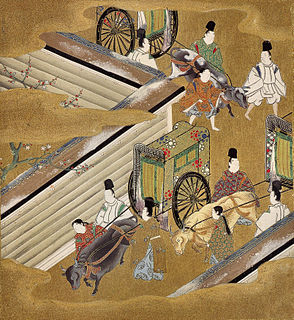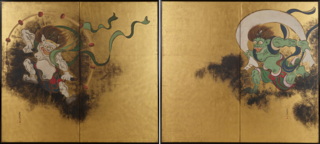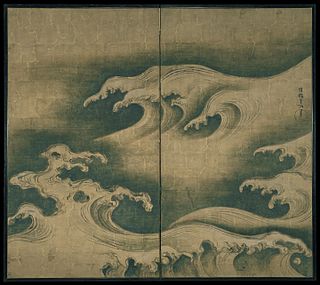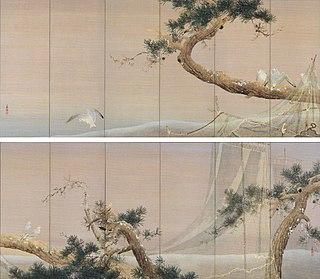Ogata Kenzan, originally Ogata Shinsei, and also known by the pseudonym Shisui, was a Japanese potter and painter.

The Kanō school is one of the most famous schools of Japanese painting. The Kanō school of painting was the dominant style of painting from the late 15th century until the Meiji period which began in 1868, by which time the school had divided into many different branches. The Kanō family itself produced a string of major artists over several generations, to which large numbers of unrelated artists trained in workshops of the school can be added. Some artists married into the family and changed their names, and others were adopted. According to the historian of Japanese art Robert Treat Paine, "another family which in direct blood line produced so many men of genius ... would be hard to find".
Ogata Kōrin was a Japanese landscape illustrator, lacquerer, painter, and textile designer of the Rinpa School.
Tawaraya Sōtatsu was a Japanese furniture designer and painter of the Rinpa school.

Tosa Mitsuoki was a Japanese painter.

Rinpa is one of the major historical schools of Japanese painting. It was created in 17th century Kyoto by Hon'ami Kōetsu (1558–1637) and Tawaraya Sōtatsu. Roughly fifty years later, the style was consolidated by brothers Ogata Kōrin (1658–1716) and Ogata Kenzan (1663–1743).

Japanese painting is one of the oldest and most highly refined of the Japanese visual arts, encompassing a wide variety of genres and styles. As with the history of Japanese arts in general, the long history of Japanese painting exhibits synthesis and competition between native Japanese aesthetics and the adaptation of imported ideas, mainly from Chinese painting, which was especially influential at a number of points; significant Western influence only comes from the later 16th century onwards, beginning at the same time as Japanese art was influencing that of the West.
Nihonga are Japanese paintings from about 1900 onwards that have been made in accordance with traditional Japanese artistic conventions, techniques and materials. While based on traditions over a thousand years old, the term was coined in the Meiji period of Imperial Japan, to distinguish such works from Western-style paintings or Yōga (洋画).

Sakai Hōitsu was a Japanese painter of the Rinpa school. He is known for having revived the style and popularity of Ogata Kōrin, and for having created a number of reproductions of Kōrin's work.

Hon'ami Kōetsu was a Japanese craftsman, potter, lacquerer, and calligrapher, whose work is generally considered to have inspired the founding of the Rinpa school of painting.

The Menard Art Museum (メナード美術館) is a museum located in Komaki, Aichi Prefecture, Japan. The museum was founded by the owners of Nippon Menard Cosmetic Co. and opened in 1987.

Red and White Plum Blossoms is an early 18th-century painting on a pair of two-panel byōbu folding screens by Japanese artist Ogata Kōrin (1658–1716). The simple, stylized composition depicts a patterned flowing river with a white plum tree on the left and a red one on the right. The plum blossoms indicate the scene occurs in spring.
Irises is a pair of six-panel folding screens (byōbu) by the Japanese artist Ogata Kōrin of the Rinpa school. It depicts an abstracted view of water with drifts of Japanese irises. The work was probably made circa 1701–1705, in the period of luxurious display in the Edo period known as Genroku bunka.
Suzuki Kiitsu was a Japanese painter of the Rinpa school.

Flowering Plants of Summer and Autumn (夏秋草図屏風) is a painting on a pair of two-folded byōbu folding screens by Rinpa artist Sakai Hōitsu depicting plants and flowers from the autumn and summer seasons.

Wind God and Thunder God is a painting on a pair of two-folded byōbu by Rinpa artist Ogata Kōrin, a replica of a similar work by Tawaraya Sōtatsu, depicting Raijin, the god of lightning, thunder and storms in the Shinto religion and in Japanese mythology, and Fūjin, the god of wind.

Rough Waves is a painting by the Japanese artist Ogata Kōrin, on a two-panel byōbu. The work was created c. 1704 – c. 1709, and depicts a swirl of stormy sea waves. It has been in the collection of the Metropolitan Museum of Art, New York, since 1926, when it was acquired with financial support from the Fletcher Fund.

Watanabe Shikō originally Kyūma or Motome was a Japanese painter of the Rinpa school. His other art names included Shōken (松軒) and Soshin (素信).

Furuya Kōrin was a Japanese artist, illustrator, and designer active in the Kyoto arts and crafts circle in the Meiji period of the late 19th and early 20th centuries. His pseudonym references Ogata Kōrin (1658–1716), also from Kyoto, and he described himself as a "Kōrin of the modern age".















